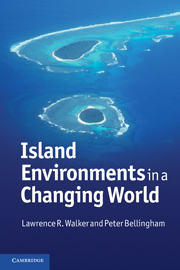Book contents
- Frontmatter
- Contents
- Preface
- Photo credits
- 1 Introduction to island environments and cultures
- 2 The physical setting
- 3 Natural disturbances on islands
- 4 The plants and animals of islands
- 5 Human dispersal, colonization, and early environmental impacts
- 6 Intensifying human impacts on islands
- 7 Islands in the modern world, 1950–2000
- 8 The future of island ecosystems: remoteness lost
- Glossary
- Index
- Plate section
- References
4 - The plants and animals of islands
Published online by Cambridge University Press: 05 June 2012
- Frontmatter
- Contents
- Preface
- Photo credits
- 1 Introduction to island environments and cultures
- 2 The physical setting
- 3 Natural disturbances on islands
- 4 The plants and animals of islands
- 5 Human dispersal, colonization, and early environmental impacts
- 6 Intensifying human impacts on islands
- 7 Islands in the modern world, 1950–2000
- 8 The future of island ecosystems: remoteness lost
- Glossary
- Index
- Plate section
- References
Summary
INTRODUCTION
Islands and their plants and animals command a place in the imagination. A cartoonist's image of a single coconut tree on an atoll instantly conjures an imaginary world of exile and self-sufficiency. Some island plants have fascinated people because of the myths that surround them, others for their size, and others for their rarity. A palm, coco-de-mer, found on two small islands in the Seychelles in the Indian Ocean, inspired erotic myths because of its voluptuous fruit, which are the largest and heaviest (up to 42 kg) of any plant. Until their native habitat was discovered in the late 1700s, all that was known of the plant was its fruits found floating at sea; these were imagined to have come from trees growing on the sea floor. Mythical large animals from islands also could have had some factual basis; for example, the giant roc, a bird that terrified Sinbad, could have been inspired by encounters with the now-extinct elephant bird of Madagascar.
The plants and animals found on islands have also provided economic wealth. Several species of frankincense trees native to the island of Socotra in the Indian Ocean contributed substantially to the wealth of Southern Arabian kingdoms 2000–3000 years ago. The incense derived from the resin of these trees was traded to the Egyptians, the Greeks, and the Romans who used it medicinally, as personal fragrances, and for religious and funeral rites.
- Type
- Chapter
- Information
- Island Environments in a Changing World , pp. 116 - 151Publisher: Cambridge University PressPrint publication year: 2011



